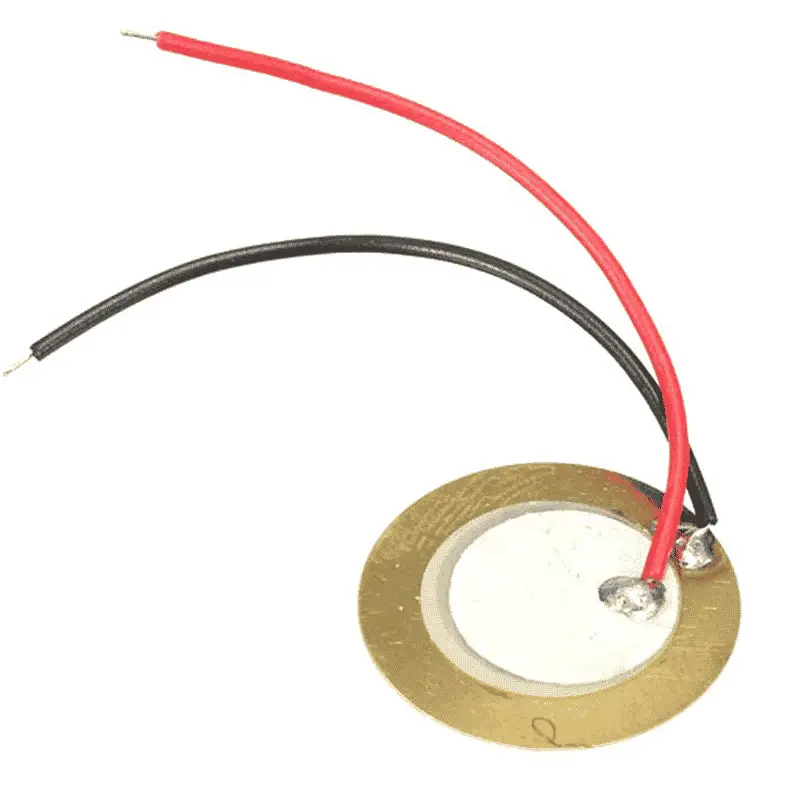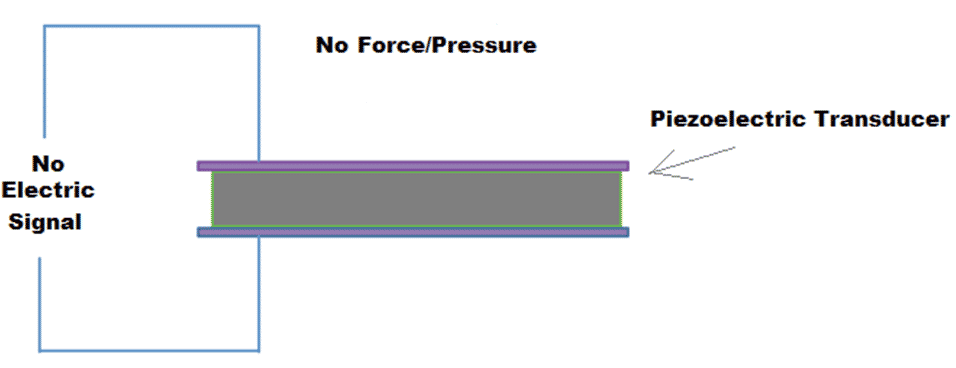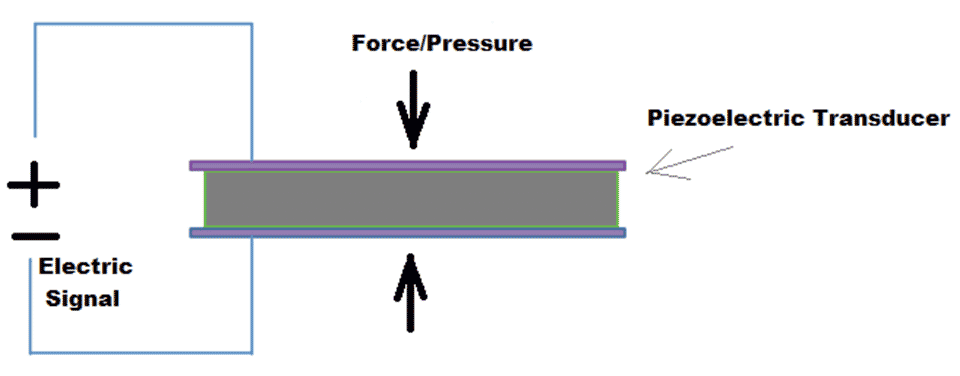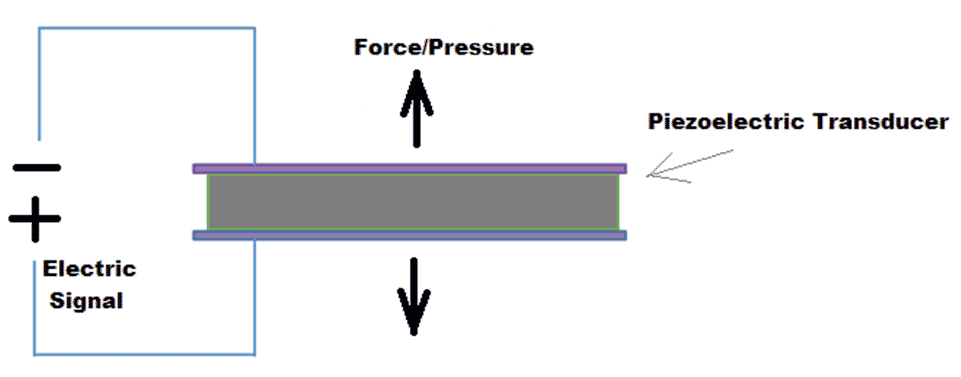The piezoelectric transducer converts mechanical motion into an electrical signal & vice versa. We will discuss the working principle of the piezoelectric transducer in this article.
The various kinds of transducers are available nowadays. A transducer is a simple device that converts one form of physical quantity into an electrical signal. The electrical signal produced from the piezoelectric transducer is used to know the quantity or say amplitude of the force or physical quantity applied to the transducer.
We will have a detailed discussion on one such type of transducer called the piezoelectric transducer. A piezoelectric transducer converts the force or pressure applied on its surface to an electric output.

Working Principle of Piezoelectric Transducer
A piezoelectric transducer utilizes the principle of the piezoelectric effect. Hence the name is a piezoelectric transducer. The piezoelectric effect is the effect in which when force or pressure is applied on certain material’s surface, an electrical output in form of electric voltage is received from the other two surfaces. The produced voltage is the function of the applied force or pressure. Because a piezoelectric transducer produces the output in the form of electric voltage, a piezoelectric transducer is a type of electric transducer.
When there is no force or no pressure applied to the piezoelectric transducer, the output electric voltage produced is also 0 i.e. no output is produced.

From the next two figures, it is very clear that the application of force or pressure produces a voltage. Now if we look at both pictures, then we can see one major difference. The difference is in the application of the force or pressure’s direction.
The below-given picture shows the polarity of voltage when tensile force applies to a piezoelectric sensor.

The below-given picture shows the polarity of voltage when compressive force applies to a piezoelectric sensor.

We sometimes call it compression and tension. So as there is a change in the direction of the force or pressure, there is a change in the polarity of the electric voltage produced. The magnitude of the electric voltage produced is dependent on the magnitude of the applied force or pressure. As the amount of the applied force or pressure increases, an increase in the magnitude of the output electric voltage is also observed. While there is a decrease in the amount of the applied force or pressure, the output electric voltage also decreases. This means that the higher the amount of the force or pressure, the higher the output voltage and vice-versa.
Very important thing to note here is that the piezoelectric transducer gives output electric voltage for only change in force or pressure. Once the force or pressure is stable, may it be of high value too, no output electric voltage is produced.
The output electric voltage produced by the piezoelectric transducer is so small that this small electric voltage cannot be directly utilized. A circuit to amplify these output electric voltage is necessary. The circuit used to amplify the electric voltage produced by the piezoelectric transducer is the amplifier circuit which is very famous and available easily in the markets.
Have you heard of ultrasonic transducers available in the market? They produce ultrasonic waves when we give an electric voltage to the ultrasonic transducer. So how are these waves produced?
The waves from the ultrasonic transducer are produced because a piezoelectric transducer is present in the circuit of the ultrasonic transducer.
The piezoelectric transducer’s shape changes as there is a change in applied electric voltage on the surface of the piezoelectric transducer. This effect is the reverse of the piezoelectric effect. In short, the piezoelectric transducer works in both ways. When given force or pressure, an electric voltage is produced and when given electric voltage as input, a change in shape is observed. The piezoelectric transducer is used in both ways in many applications in our day-to-day life.
The piezoelectric transducer consists of a quartz crystal that is made up of SiO2 i.e. Silicon dioxide or Barium Titanate Lead Zirconate Titanate (PZT) or Rochelle salt.
Application of Piezoelectric Transducer
- The earphones we use for hearing songs or watching videos make use of a piezoelectric transducer. The piezoelectric transducer produces sound waves as an output for a given electric signal from the mobile phone.
- In the modern medical field, ultrasonic imaging uses the piezoelectric transducer.
- A seismograph that measures vibrations, makes use of a piezoelectric transducer.
- On roads, piezoelectric transducers are laid. Whenever there is any movement on the road, vibrations are produced. This vibration is an input for the piezoelectric transducer and an electric voltage is harvested using this.
- Piezoelectric transducers are used for dynamic pressure measurement and dynamic vibration measurement too.
- In industries to know the varying force or pressure, piezoelectric transducers are used.
Advantages of Piezoelectric Transducers
- Piezoelectric transducers are a kind of active transducers and hence they do not need any electric supply for their working.
- Piezoelectric transducers have a good high-frequency response and hence piezoelectric transducers are used for wide applications because of their quick response.
- Piezoelectric sensors are compact in size which is very beneficial while designing small circuits.
Limitations of Piezoelectric Transducers
- Piezoelectric transducers cannot be used for those applications that have static forces.
- The piezoelectric transducer’s output is also affected by temperature change.
- An external circuit to amplify the output from the Piezoelectric transducer